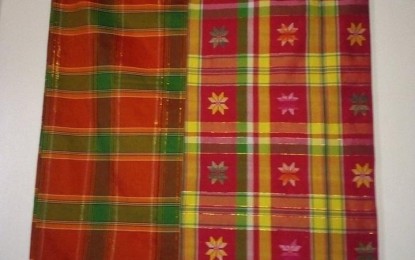By Annabel Consuelo Petinglay/PNA

SAN JOSE DE BUENAVISTA, Antique — Antiqueños engaged in loom weaving as livelihood have increased more than four-fold since 2007.
Mario Manzano, president of the Bagtason Loom Weavers Association in Bugasong town, said that only about 15 persons were into weaving “patadyong” (loose-checkered skirt), their main product, when they reorganized the loom weavers in their municipality in 2007.
“Right now, we have 72 weavers of whom nine are males and the rest are females,” said Manzano in an interview Tuesday.
He said the industry began in Bugasong back in the pre-Hispanic times where women engaged themselves in “patadyong” weaving as occupation right in their homes. During this time, “patadyong” was used as a mosquito net or hammock.
“The weaving industry however waned when the Chinese textiles in the 1960s penetrated the market,” he said.
He said that the Chinese textile was then preferred as it was sold cheaper than the woven cloth.
“The Bagtason Loom Weavers Association, through the assistance of the Department of Trade and Industry (DTI), was established to encourage residents of Bugasong to produce and again market their own local product,” Manzano said.
With assistance from the DTI, Manzano said they conducted trainings to other interested individuals whom they ultimately hired as workers.
Because of the renewed and growing demand for “patadyong”, and in order to keep up with the modern trend, they introduced new products such as shawl, scarf, handkerchief, and bag, among others.
“We now have a trained weaver in Barangay Egana in Sibalom,” said Manzano, as plans are afoot to expand their weaving industry in Valderrama town.
He said their products could be distinguished from the “patadyong” produced in other places through their Sampaguita flower design.
He said that their product also has a distinct red color and is thicker.
“We use cotton and polyester, but we are also mixing abaca fiber,” Manzano said.
He said that the abaca fiber is ordered from the producers in Aklan, known for its abaca hand-woven fabric.
He said that they are now coordinating with the Fiber Industry Development Authority (FIDA) on where they could source out more abaca fiber.
Currently, the Bagtason members have 52 “tirals” or wooden loom for weaving. Weavers, if they want to earn more, have to work early so that other workers could take turn in using the weaving machine. “A worker is being paid per piece,” Manzano said.
A worker who finishes one shawl a day can earn as much as PHP166 per piece or PHP5,000 per month, which could be doubled depending on the number of their finished products.
He said their group has joined different trade fairs like those organized by the Department of Tourism (DOT) in Manila or even abroad.
Only last November 10 to 11, the product of Bagtason was featured in the Likhang Pamana Fashion Show at Sheraton Hotel in Hong Kong. Local designer Wilthe Popelo was among the 10 designers around the country invited by the DOT to join the event.
